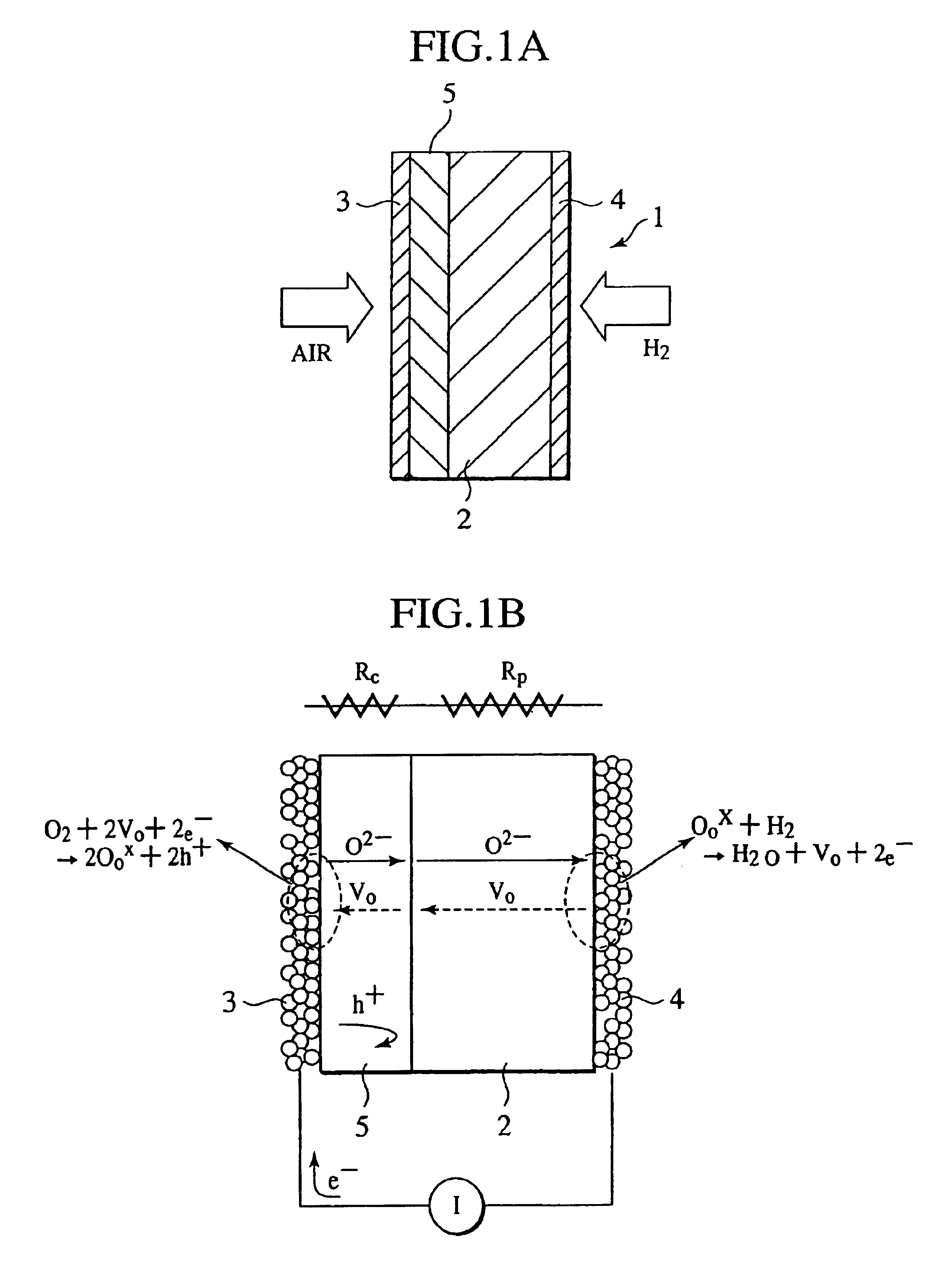Solid oxide fuel cell having perovskite solid electrolytes
a solid electrolyte, solid oxide fuel cell technology, applied in the manufacture of final products, cell components, electrochemical generators, etc., can solve the problems of high material cost and difficulty in securing operational stability and reliability of sofc, and achieve the effect of suppressing mixed conductivity, increasing the substantial transport number of oxygen ions, and high oxygen ion conductivity
- Summary
- Abstract
- Description
- Claims
- Application Information
AI Technical Summary
Benefits of technology
Problems solved by technology
Method used
Image
Examples
first embodiment
(First Embodiment)
The SOFC of the first embodiment of the present invention has a structure where a second solid electrolyte layer having a low ratio of hole conduction (i.e. hole transport number) and a high ratio of oxygen ion conduction (i.e. oxygen ion transport number) at an operational temperature is provided between an air electrode and a perovskite solid electrolyte layer. In other words, the SOFC of the first embodiment is characterized by the use of a laminated solid electrolyte having a perovskite solid electrolyte layer and a solid electrolyte layer of a small hole transport number laminated thereon.
FIG. 1A shows the SOFC according to the first embodiment of the present invention. As shown, the SOFC 1 of the first embodiment comprises a perovskite solid electrolyte layer 2 as a first solid electrolyte layer; a fuel electrode 4 formed on one surface of the first solid electrolyte layer; and an air electrode 3 formed on the opposite side thereof, with a second solid electr...
second embodiment
(Second Embodiment)
The SOFC of the second embodiment has a structure where a third solid electrolyte layer having a low ratio of electron conduction (i.e. electron transport number) and proton (mainly H+) conduction (i.e. proton transport number) and higher ratio of conduction by means of oxygen ions (i.e. oxygen ion transport number) is provided between the fuel electrode and the first a solid electrolyte layer. In other words, the SOFC of the second embodiment is characterized by the use of a laminated solid electrolyte in which the perovskite solid electrolyte layer and the solid electrolyte layer (having low electron and proton transport numbers and high oxygen ion transport number) are laminated.
FIG. 3A shows the SOFC of the second embodiment of the present invention. As shown in FIG. 3A, the SOFC 1 of the second embodiment comprises a perovskite solid electrolyte layer as a first solid electrolyte layer 2; an air electrode 3 formed on one surface of the first solid electrolyte...
third embodiment
(Third Embodiment)
The SOFC of the third embodiment has a structure where a second solid electrolyte layer having a low ratio of hole conduction (i.e. hole transport number) and high ratio of oxygen ion conduction (i.e. oxygen ion transport number) is provided between an air electrode and a solid electrolyte, and a third solid electrolyte layer having a low ratio of electron and proton conduction (i.e. electron and proton transport numbers) and high ratio of oxygen ion conduction (i.e. oxygen ion transport number) is provided between a fuel electrode and the first solid electrolyte layer. In other words, the SOFC of the third embodiment is characterized by the use of a laminated solid electrolyte in which the second solid electrolyte layer having a small hole transport number and high oxygen ion transport number, the first perovskite solid electrolyte layer, and the third solid electrolyte layer having small electron and proton transport numbers and high oxygen ion transport number, ...
PUM
| Property | Measurement | Unit |
|---|---|---|
| temperature | aaaaa | aaaaa |
| conductivity | aaaaa | aaaaa |
| oxygen ion conductivity | aaaaa | aaaaa |
Abstract
Description
Claims
Application Information
 Login to View More
Login to View More - R&D
- Intellectual Property
- Life Sciences
- Materials
- Tech Scout
- Unparalleled Data Quality
- Higher Quality Content
- 60% Fewer Hallucinations
Browse by: Latest US Patents, China's latest patents, Technical Efficacy Thesaurus, Application Domain, Technology Topic, Popular Technical Reports.
© 2025 PatSnap. All rights reserved.Legal|Privacy policy|Modern Slavery Act Transparency Statement|Sitemap|About US| Contact US: help@patsnap.com



